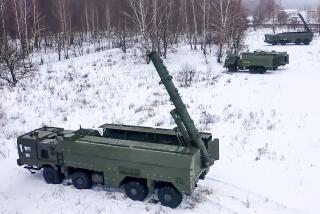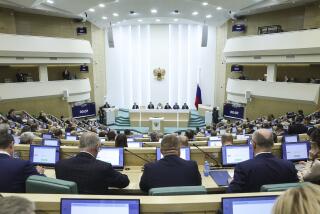1954 War Games Used Real Nuclear Bomb
- Share via
MOSCOW — As the summer of 1954 came to an end, an entire Soviet infantry corps was moved with its equipment from Byelorussia to the desolate plains of Kazakhstan. Its mission: engage in combat in conditions duplicating a nuclear war.
On Sept. 13, more than 40,000 soldiers were massed in two formations on the sunbaked steppe, and a nuclear bomb exploded between them, 1,150 feet in the air. In the choking pall of radioactive dust and to the accompanying thunder of artillery, the men of the Red side then tried to overrun the positions of the Blues.
In a chilling expose last summer, Moscow News recounted the story of these hapless young soldiers, many of whom were not issued gas masks or protective gear and who were not warned in advance about the effects of radiation. Some of those who did have gas masks even took them off, so stifling was the heat that day, the paper said.
How many of these soldiers stationed in Byelorussia (now Belarus) became infirm or died as a result of the military exercise at Totsk will probably never be known. One participant who is still alive, Ernest Kan, began to suffer chronic headaches four years later. “His bones went soft, his liver and lungs gave him trouble,” Moscow News said. “His thorax and spine had become deformed by 1967, and he had to wear a plaster-of-Paris bodice.”
Four years ago, Kan tried to seek treatment in a military garrison clinic but was turned away. “This is disgusting. We’ve just been left to our own devices,” he complained. “Even the test animals brought on the site were monitored for several years. We were simply (demobilized).”
Only 1,000 of the Totsk veterans are known to still be living; none is in good health, Moscow News said. Even now, it added, authorities do not tell them the truth. When Totsk veterans met with generals recently, the generals tried, but failed, to persuade the survivors that the blast they had witnessed was an “imitation.”
Soviet “nuclear veterans” have formed the Committee of Special Risk Contingent Veterans, whose membership now numbers 6,000. Also eligible are survivors among the 6,000 men who used to work at the Semipalatinsk and Novaya Zemlya nuclear test sites, assembling warheads in conditions of frequently high radioactivity.
Each year, the dwindling ranks of the “nuclear veterans” take part in the May 9 parade down St. Petersburg’s Nevsky Prospekt marking VE day.
The men complain that they are being given the runaround by the Defense Ministry, which claims it has difficulty finding confirmation in its archives of the veterans’ involvement in Soviet nuclear programs. Other Russian government agencies have shown little desire to help.
“Looking at us, you can see the future of those affected by Chernobyl,” many of the nuclear veterans say.
More to Read
Sign up for Essential California
The most important California stories and recommendations in your inbox every morning.
You may occasionally receive promotional content from the Los Angeles Times.













